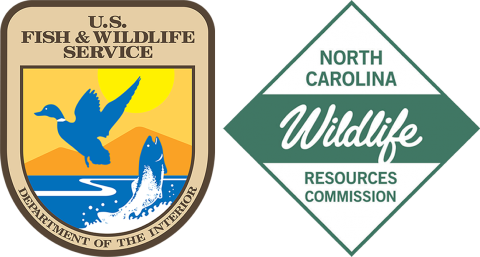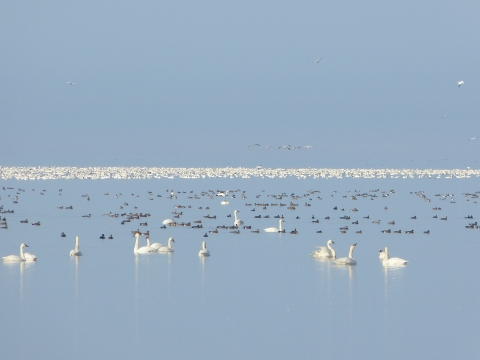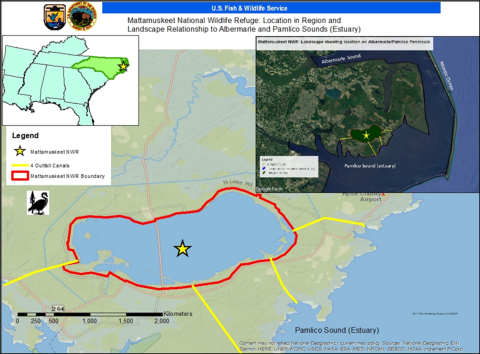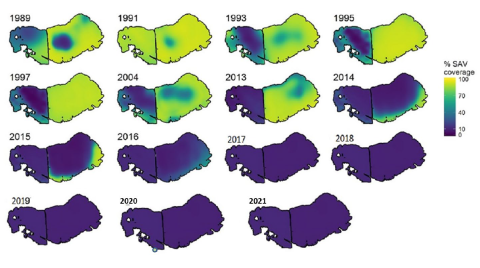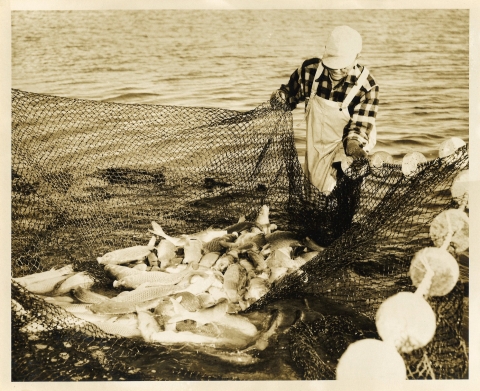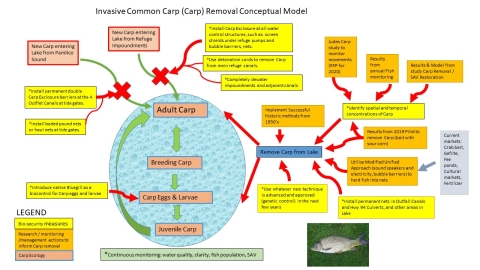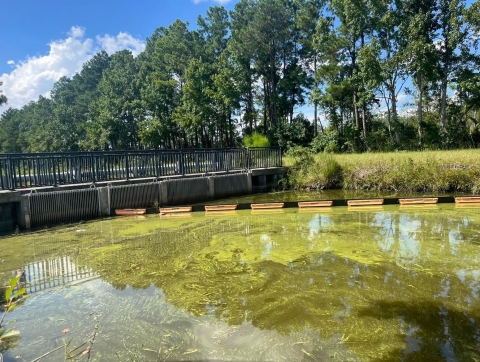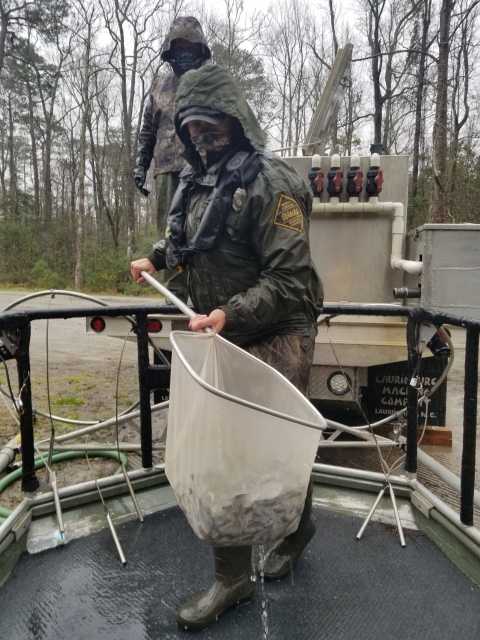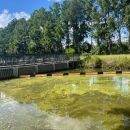Mattamuskeet National Wildlife Refuge and the North Carolina Wildlife Resources Commission (NCWRC), working together as the Mattamuskeet Technical Working Group (abbreviated TWG), have been awarded $1 million dollars by the U.S. Fish and Wildlife Service’s Large Invasive Species grant program to remove invasive common carp (Cyprinus carpio) from Lake Mattamuskeet. The removal of common carp from impaired aquatic systems has been an effective management action to increase water clarity, reduce nutrient concentrations, and to reestablish submerged aquatic vegetation (SAV). Historic common carp removal efforts during the 1950s in Lake Mattamuskeet resulted in improved water clarity and an increase in SAV coverage. This action is supported by the Lake Mattamuskeet Watershed Restoration Plan that was released in 2018 as the result of a multi-stakeholder effort consisting of the U.S. Fish and Wildlife Service, NCWRC, Hyde County and local stakeholders. The North Carolina Coastal Federation was contracted to facilitate the collaboration.
A significant number of partner agencies and organizations have been involved in efforts to remove carp and restore SAV in Lake Mattamuskeet. While there are too many partners to list individually, we deeply appreciate the contributions of each partner and look forward to developing new and innovative partnerships in the future. Funding for Lake Mattamuskeet Restoration is provided by a variety of sources, including the USFWS Coastal Program and the Sportfish Restoration Program. Actions related to carp removal and SAV restoration are guided by a Memorandum of Understanding with the NCWRC and Hyde County.
Table of Contents
Significance of Lake Mattamuskeet
Decline of Submerged Aquatic Vegetation
Common Carp History and Impacts
Understanding Invasive Common Carp in the Lake
Common Carp Removal Techniques
Mattamuskeet Watershed Restoration Plan
Latest News (scroll to bottom)
Significance of Lake Mattamuskeet
Lake Mattamuskeet is the 40,000-acre (16,314-hectare) centerpiece of the Mattamuskeet NWR in Eastern North Carolina. The lake’s size and strategic location along the Atlantic Flyway make it the area’s premiere overwintering site for migratory waterfowl, including tundra swans (Cygnus columbianus), dabbling ducks (e.g., northern pintails (Anas acuta), and diving ducks (e.g., ring-necked ducks [Aythya collaris]), migrant Canada geese (Branta canadensis) and snow geese (Anser caerulescens). Lake Mattamuskeet also provides year-round habitat and food resources for a plethora of wetland-dependent wildlife, namely nesting habitat for osprey (Pandion haliaetus) and great blue heron (Ardea herodias) rookeries and resting and feeding areas for long-legged wading birds and shorebirds. Beneath the surface, Lake Mattamuskeet supports several economically and ecologically valuable freshwater fish, such as largemouth bass (Micropterus salmoides), black crappie (Pomoxis nigromaculatus), and bluegill (Lepomis macrochirus). Lake Mattamuskeet is connected to the Pamlico Sound through four main drainage canals. This unique connection creates a corridor for diadromous fish and crustaceans to utilize lake habitats including alewife (Alosa pseudoharengus), American eel (Anguilla rostrata), and blue crab (Callinectes sapidus), which are highly regarded for their large size.
The refuge attracts over 58,000 visitors annually for educational and recreational activities such as hunting, fishing, crabbing, wildlife observation, and photography. Collectively, Lake Mattamuskeet’s rich history, cultural significance, and biodiversity make it a unique and invaluable public destination for Hyde County and North Carolina.
Decline of Submerged Aquatic Vegetation
In shallow lake systems such as Lake Mattamuskeet (averaging just three feet in depth), an abundance of SAV is a critical component of ecosystem health. By stabilizing the substrate of the lake, SAV prevents wind-driven re-suspension of fine sediments and provides critical habitat and food sources for birds, fish, and invertebrates. Historically, Lake Mattamuskeet has been a healthy system dominated by thick beds of SAV, including wild celery (Vallisneria americana), sago pondweed (Stuckenia pectinata), southern naiad (Najas guadalupensis), redhead grass (Potamogeton perfoliatus), and macro algae (Chara and Nitella spp).
Today, the Lake Mattamuskeet substrate is barren, having suffered a total loss of SAV. Declines in SAV were first observed in the late 1990s. By 2017, refuge staff were unable to locate a single plant during the annual SAV survey. Declines in SAV in the lake are attributed to poor water quality and clarity. Increases in total suspended solids, nitrogen and phosphorous in the lake contribute to large blooms of phytoplankton and cyanobacteria. These blooms outcompete SAV and decrease the clarity of lake water, preventing light from reaching SAV and eventually killing it (Piehler et al. 2020). Over time, the lake shifted from an SAV-dominated system to a phytoplankton/cyanobacteria-dominated one.
The Mattamuskeet Technical Working Group identifies, prioritizes, and conducts monitoring and research at Mattamuskeet NWR to inform management actions that can be implemented to improve water quality and restore SAV in Lake Mattamuskeet. The TWG has been working to understand the declines in SAV through the lens of a conceptual model published by Brinson and Davis (1980). This model has helped guide and develop recommended monitoring and research needs to help inform the restoration of SAV in the lake. In addition, SAV has been identified as the indicator of water quality and clarity in the lake.
In 2016, the N.C. Division of Water Resources listed the lake on the 303(d) list of impaired waters due to high pH and chlorophyll-a, both indicators for cyanotoxin-producing cyanobacteria harmful algal blooms (cyanoHABs). Further monitoring efforts confirmed that three cyanotoxins, cylindrospermopsin, microcystin, and saxitoxin were present in the lake, with cylindrospermopsin concentrations bordering federal limits for recreation contact (Moorman et al., 2018). The loss of SAV and rise in harmful algal blooms render the lake’s habitat dysfunctional for its waterfowl and other wildlife and fisheries.
Common Carp History and Impacts
The ecosystem changes observed in Lake Mattamuskeet are also attributed to the high biomass of invasive common carp found in the lake and its associated canals. Common carp are one of the most widely-introduced and ecologically-disruptive freshwater fishes throughout the world. Carp can directly uproot established SAV beds during feeding. Additionally, this grazing activity resuspends sediments, increases turbidity, and limits the establishment of new SAV. The loss of SAV and increased nutrient availability can have devastating impacts on fish and aquatic invertebrate species that rely on SAV for spawning, rearing, and feeding.
The removal of invasive common carp from impaired systems is commonly used as a management tool and has repeatedly been associated with increased water clarity, reduced nutrient concentrations, and reestablishment of SAV. Common carp were first identified as a problematic species in Lake Mattamuskeet in the 1940s, when they were identified as a major contributor to increased turbidity that prevented the growth and survival of SAV. That led to a significant effort to remove common carp and restore SAV to the lake during the 1940s and 1950s. Striped bass (Morone saxatilis), a known predator of common carp, were also stocked into the lake in 1950 through 1972. The introduction of predators helped control populations of carp following carp removals. These early efforts to restore the lake were ultimately successful, with water clarity increasing from less than 0.5ft (0.16m) to over 2ft (0.6m) and SAV expanding to an estimated 16,000 acres (6,475 hectares) of the lakebed. This SAV thrived for over 60 years until the most recently observed decline began in the 1990s. During this time period, there was an increase in excessive nutrients and sediments entering the lake and carp were able to easily access the lake through the four outfall canals. Please see Cahoon (1953) for additional details.
Understanding Invasive Common Carp in the Lake
In order to better understand the current-day common carp population in Lake Mattamuskeet, graduate student April Lamb conducted a study from 2017 to 2020 that examined the feasibility of carp removal and SAV restoration. As part of this study, standard age and growth techniques and yearly carp sampling data were used to determine the baseline population demographics of carp in Lake Mattamuskeet. These efforts indicate that the carp population is relatively young and fast growing, which is typical of warm, shallow systems at Southern latitudes. A mark-recapture study was then conducted to generate a population and biomass estimate, which estimated an abundance of 971,220 (95 confidence interval: 566,545, 1,910,066) individuals at a biomass of 124 kg · ha-1 (CI: 73, 245) This density is well above the reported global minimum threshold for ecological impairments in shallow systems due to carp presence (50 kg · ha-1). Furthermore, the confidence interval falls within the range (178-300 kg · ha-1) for which a phase shift (i.e. from “clear water”, macrophyte-dominated to turbid, phytoplankton-dominated) is expected, suggesting that invasive common carp are likely contributors to the observed ecological conditions in Lake Mattamuskeet. Very few studies have characterized common carp populations in the Southeast, so this critical threshold may be lower for warm, shallow, and dynamic systems like Mattamuskeet.
In January 2020, Lamb showed that transplanted stands of wild celery will successfully establish and grow in Lake Mattamuskeet when protected from carp. However, the SAV did not survive after the first year. In addition, research conducted by Piehler (Piehler et al. 2020) had similar results from wild celery plantings in the east and west basins. Plantings persisted for seven months when protected from grazing, but no plantings persisted for a year. This research reinforces that the eradication/removal of common carp and the installation of re-entry barriers with two-inch wide spacings at water control structures will be pivotal for the restoration of SAV in the lake. If SAV is not restored, the Refuge will not be able to provide necessary aquatic resources for waterfowl, waders, diadromous fishes and other species that depend on SAV.
Common Carp Removal Techniques
In order to remove the common carp, refuge staff, partners, and contractors will employ a range of techniques to block carp movement and remove carp in the lake.
Strategy 1: Prevent new common carp from entering the lake and inhibit carp movement within the refuge.
Although adult common carp can survive the brackish water in the Pamlico Sound, they require freshwater for breeding and for the eggs and larvae to survive. Each of the four outfall canals have a tide gate that opens when the head pressure is greater on the lakeside. This prevents the saltier sound water from entering the lake but allows drainage of lake water into the sound. To prevent the passage of common carp, two layers of carp exclusion barriers will be installed at the tide gates of each outfall canal. This double barrier will provide biosecurity and prevent entry of new carp, but still allow safe passage for smaller-bodied diadromous fish and crustaceans including alewife, American eel, and blue crabs. The primary barrier has two-inch spacings that block entry of new invasive common carp, but provide passage for diadromous fish, native fish and blue crabs. This video shows how carp are unable to get through the barrier.
Strategy 2: Remove common carp in the lake
An integrated pest management (IPM) and adaptive approach will employ multifaceted common carp removal techniques and will incorporate findings from recent studies. During a 2019 pilot project, the carp team successfully collaborated with commercial fishermen to remove more than 26,500 pounds (12,000kg) of common carp from the lake using baited traps and seine nets. The common carp project will use this strategy with larger nets and gear, which have shown to be more effective at capturing large quantities of common carp. Removal will also incorporate other effective techniques, such as the modified unified method, which uses underwater speakers and electricity to herd fish into nets; permanent nets at known spawning concentrations; and stocking of native bluegill, which predate common carp eggs and larvae.
The commercial fishermen can work with suitable markets for removed common carp and dispose of unmarketable carp. Carp is used in many cuisines, including several signature European and Asian dishes. Fee fishing ponds often purchase live carp to stock their ponds. In addition, carp can be used as crab bait, fish meal, and fertilizer.
Lake Mattamuskeet Watershed Restoration Plan
In a multi-stakeholder effort to improve water quality in Lake Mattamuskeet, the U.S. Fish and Wildlife Service worked closely with North Carolina Wildlife Resources Commission and Hyde County. In addition, the U.S. Fish and Wildlife Service and Hyde County contracted with the North Carolina Coastal Federation to develop the Lake Mattamuskeet Watershed Restoration Plan. The collaborative process involved stakeholders and public engagement. The plan was approved by the North Carolina Department of Environmental Quality in 2019. The plan includes Best Management Practices (BMPs) and strategies aimed to improve Lake Mattamuskeet’s water quality and restore SAV to the lakebed. Among these, two strategies were identified as priority actions necessary for successful restoration of the lake: a reduction in carp biomass and a reduction in external nutrient loading from runoff. While existing research and results from Lamb suggest that carp removal alone is significant enough to cause drastic improvements in ecosystem health, it was agreed that a multifaceted approach would yield the highest probability of long-term success. These efforts complement the goals outlined in the Mattamuskeet NWR’s Habitat Management Plan, which calls for the removal of 75% of the standing carp biomass for the purpose of promoting SAV restoration and improving water clarity. In addition, Lake Mattamuskeet discharges into the Albemarle-Pamlico estuary, which is the second-largest estuarine system in the United States and provides important habitat for the Carolina Distinct Population Segment for Federally endangered Atlantic sturgeon (Acipenser oxyrhynchus) and shortnose sturgeon (Acipenser brevirostrum). Nutrient enrichment has been identified as the major pollutant in the estuary, raising concerns about the potential impacts to sturgeon and other species of concern from the nutrient and bacteria rich waters that discharge from Lake Mattamuskeet.
Successful completion of this project will lead to an improvement in Lake Mattamuskeet’s water quality, water clarity, and habitat quality and quantity by promoting the reemergence and successful restoration of SAV and ultimately the renewal of one of the premiere Atlantic Flyway overwintering waterfowl sites. Subsequently, these improvements will also provide direct ecosystem benefits to the Albemarle-Pamlico Estuary.

